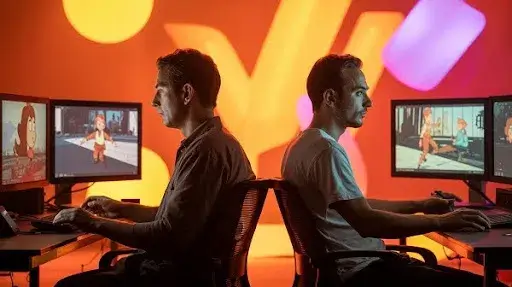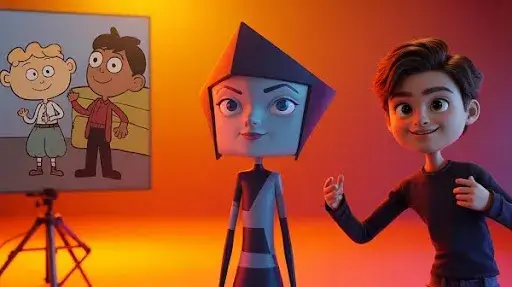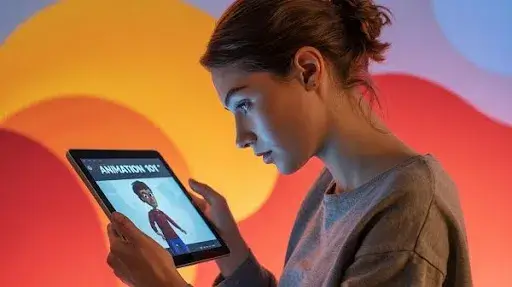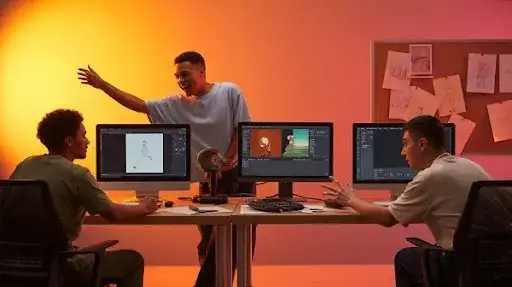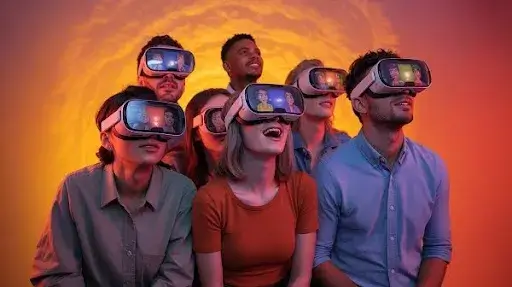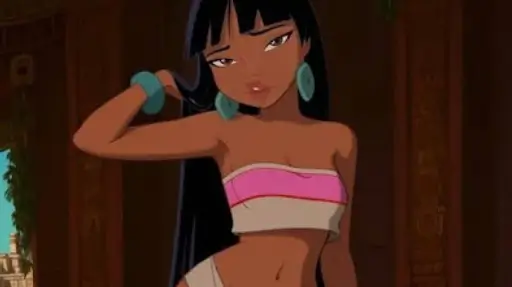Think back to the last animated character that grabbed your attention. Maybe it was a Pixar kid with oversized eyes, or a villain in a game who had more charm than they should’ve. Strange thing is, they aren’t real at all. Just sketches, pixels, or little lumps of clay. And still, they manage to breathe.
That’s the real magic of character animation. It’s not about sliding a puppet across a timeline. It’s about slipping in the quirks that make us care. A grin that shows up a beat too late. A stumble that feels clumsy in the right way. These small accidents make us forget we’re staring at something fabricated.
At Prolific Studio, this is what we chase. Animation is our way of giving designs a spark. In this guide, I’ll show you what character animation means, the steps that bring it to life, the styles you’ll find out there, and how you can start experimenting if the idea excites you.
So, What is Character Animation Anyway?
At its core, it’s the art of creating believable performances. Not necessarily hyper-real humans, but convincing enough that your brain buys it.
It isn’t about dragging an arm here or rotating a head there. It’s about weight in a slouched shoulder, the flicker in the eyes before a line, or the exaggerated bounce in a cartoon jump. These little cues speak volumes about a character—without a single word.
Every character animation studio is after the same thing: breathing soul into shapes. For some, it comes from the softness of hand-drawn character animation. For others, it’s hidden in the micro-movements of 3D human and animal characters. The medium may change, but the goal doesn’t.
Disney’s 12 Fundamental Principles of Animation (from The Illusion of Life, 1981) originated from methods established in the 1930s, and they continue to be essential to character animation now—particularly concepts such as squash & stretch, timing, anticipation, and appeal.
The Animation Pipeline
Animations don’t just appear. They crawl through a series of steps, with each one layering on more personality.
- Character Design
This is the birthplace of personality. Artists test rough sketches, stretch shapes, adjust proportions, and play with colors. A round design often feels approachable. Sharp angles? They usually scream trouble. Even the shades chosen say something.
Picture a statue. Beautiful, but frozen. Rigging is like sliding a skeleton under it. Suddenly, the model bends, twists, and even dances. Without a rig, your character can’t move.
- Key Poses
Before the in-betweens, animators block out the big beats: a crouch before a leap, a tilt of the head before a line. These poses are anchors that hold the performance together.
- Refinement
Early passes always look stiff. This is where personality sneaks in—squash and stretch techniques from animation, anticipation, and follow-through. A cape dragging just behind the runner, a fist landing with a snap, a stumble that makes you laugh.
- Facial Animation
Bodies act, but faces reveal the truth. Blinks, tiny eye movements, a lip curl. Without them, you’re looking at a mannequin.
- Polish and Render
The last sweep. Smoothing timing, adding shadows, lighting, reflections in 3D; crisp lines and finishing touches in 2D. This is where things finally look polished.
The Main Types of Character Animation
Different goals call for different methods. Here are the big ones:
- Hand-Drawn Animation
Oldest method, and still charming. Artists draw frame after frame—sometimes 24 per second. It’s painstaking, but nothing feels as warm and expressive.
- 2D Vector Animation
The modern, digital shortcut. Instead of redrawing, artists use vector software to shift and stretch shapes. Clean, scalable, fast. Great for brand mascots or explainer clips.
- 3D Animation
The heavyweight of today. From Pixar films to AAA games, 3D animation services dominate. Here, animators sculpt, rig, and animate characters with details like subtle breathing and shifting muscles.
- Stop Motion
Toys, clay, puppets—moved a hair at a time, photographed frame by frame. Painfully slow, but that handmade quality is impossible to fake.
- Motion Graphics with Character Elements
These aren’t full animations, but you’ll spot them in ads or app interfaces. Even a waving mascot adds charm.
Stylized Characters vs. Realistic Characters
One of the earliest calls an animator makes: go big and bold, or keep it grounded.
- Stylized Characters Animation
Exaggerated shapes, bright palettes, expressive movements. Anime heroes, cartoon mascots, game avatars. They aren’t about realism—they’re about grabbing attention.
- Realistic Characters
Here, precision matters. Every twitch, every muscle flex is tuned. Studios often lean on motion capture to hit that level of detail.
Both work. The choice depends on story and audience. A goofy ad mascot doesn’t need veins popping in its arms. A cinematic game character does.
How a Character Animation Studio Pulls it Together
Behind every polished shot is a crew, not just one person. Writers, designers, animators, and directors all feed into the pipeline. The process usually goes like this:
- Build out personality, backstory, and traits.
- Pick an animation style that matches the project.
- Move through design, rigging, and animation.
- Test the final against the bigger goal—sell, teach, or entertain.
At Prolific Studio, one of the best animation studios in Atlanta, we keep one thing at the center: emotion. Motion matters, but what lasts is how a character makes the audience feel.
A Beginner’s Roadmap
From the outside, animation looks overwhelming. But broken down, it’s easier to start than you’d think.
- Learn the Principles
Timing, squash-and-stretch, anticipation. The twelve principles are the roots of good animation.
- Practice Art
Even if you’re drawn to 3D, sketching gestures and anatomy sharpens your eye.
- Pick Your Tools
For 2D: Adobe Animate, Toon Boom, Synfig.
For 3D: Blender (free), Maya, 3ds Max.
- Start Small
Don’t try an action-packed fight first. Do a bouncing ball, a walk cycle, a lip-sync. These mini-projects train your instincts.
- Create a Portfolio
Gather your best clips into a reel. Show range—funny, serious, subtle, over-the-top. Studios want to see variety, not just polish.
2D vs. 3D at a Glance
Flat visuals, smaller file sizes, faster turnaround. Great for ads, stylized shorts, and apps.
Adds depth, realism, and weight. Slower to produce, but essential for films, VR, and detailed character projects.
Sometimes, a playful 2D mascot is more powerful than a realistic 3D figure. The trick is picking the right medium for the message.
Why Character Animation Matters More Than You Think
Most people still put animation into the “cartoon” box. They imagine Saturday morning shows, Disney classics, or kids’ movies. But if you look around carefully, character animation is quietly everywhere. It’s in the ad that makes you laugh before you scroll away. It’s in the training video at your workplace. It’s even in your fitness app when a friendly mascot counts your steps.
Animation has become more than just entertainment—it’s communication. A moving character, no matter how simple, does something text or still images can’t: it holds attention.
Take advertising. A mascot with exaggerated movements and a cheeky grin can give a faceless brand a personality. Education, too, leans heavily on character animation services—think of those interactive math apps where a character cheers you on.
Hospitals and corporations use animated guides to walk people through procedures or training. Why? Because humans naturally respond to characters.
And then there’s gaming, where animation isn’t just decoration—it’s the backbone of the experience. Without animation, games are just button presses. That feeling of weight when a sword connects, or the subtle smirk of a rival character—that’s the animator’s invisible hand at work.
So no, animation isn’t just “fun.” It’s practical. It’s storytelling that earns its keep.
Tools and Software That Drive Character Animation
The choice of software shapes the outcome. Each tool carries its own strengths, and professional studios don’t pick one because it’s trendy; they pick it because it fits the project.
For 2D Animation Services
- Adobe Animate – a classic in advertising and web animation. Ideal for brands that want a polished but light look.
- Toon Boom Harmony – the heavyweight for TV shows and feature-level 2D work. Studios lean on it when frames need to flow seamlessly.
- Synfig Studio – an open-source option. Free, accessible, and perfect for newcomers testing the waters.
For 3D Animation Services
- Autodesk Maya – the industry giant. Blockbuster films, cinematic ads, and AAA games all rely on it.
- Blender – free yet surprisingly powerful. Its community-driven updates make it a favorite among freelancers and small character animation studios.
- 3ds Max – also from Autodesk, often used in games and architectural projects where detailed 3D modeling is essential.
For Stop Motion and Mixed Media
- Dragonframe – the standard for stop motion. Used in films like Kubo and the Two Strings. Painstakingly slow, but it captures that handmade charm.
- After Effects – not a character-first tool, but great when you need motion graphics blended with animated characters.
A good studio won’t just chase the “best” software. They’ll consider style, timeline, and budget, then choose what delivers.
Character Animation in Games
Nowhere does animation get tested harder than in games. Unlike films, games are interactive—your decisions drive what happens. That means animation has to not only look convincing but also respond instantly.
- Combat Systems: A sword swing has to feel heavy. A punch needs that snap of impact. Animators spend weeks tuning timing so combat feels rewarding.
- Emotional Hooks: Players might spend 40–60 hours with a single character. That bond only works if gestures and expressions feel alive.
- Feedback Loops: Every dodge, miss, or strike is communicated through animation. Without it, gameplay would feel hollow.
This is why character animation services in gaming often blend performance capture with hand-crafted keyframes. The balance between realism and playability is delicate—and when it’s right, you don’t even notice. You just feel it.
Common Beginner Mistakes (And How to Avoid Them)
Everyone starts somewhere, and mistakes are part of the process. But some errors repeat so often they’re worth flagging:
- Jumping into complex projects too soon
Many beginners want to animate fight scenes or emotional monologues right away. The truth? A simple bouncing ball teaches more about weight and timing than any fight sequence at first.
- Skipping the principles
Those famous “12 principles of animation” aren’t just history—they’re survival tools. Squash, stretch, anticipation, follow-through… leave them out and your work will feel mechanical.
- Forgetting about weight
A bowling ball and a feather don’t land the same way. The same logic applies to characters. Without believable weight, even the slickest rig falls flat.
- Flat facial animation
New animators often nail body movement but leave faces stiff. Yet audiences connect most strongly through eyes, brows, and mouths. A blink or smirk often says more than a whole gesture.
- Not building a reel
Sharing random clips isn’t enough. Studios want to see a curated reel that shows variety—serious, funny, subtle, exaggerated. A strong reel is your ticket into any character animation studio.
Where Character Animation is Headed
Animation has always evolved with technology, but right now, it’s changing faster than ever.
- AI-Assisted Animation: Machine learning tools are starting to fill in “in-betweens” or automate lip-sync. These save hours, but the emotional beats—the parts that make us care—still come from human animators.
- Virtual and Augmented Reality: In VR and AR, characters have to react instantly to users. That requires collaboration between animators and developers like never before.
- Cross-Media Characters: A mascot might debut in a mobile app, show up in a short film, and then pop into a brand’s social content. Characters are now designed with multi-platform storytelling in mind.
- Blending Realism with Style: Expect more hybrid designs—not fully realistic, not overly cartoony. Enough believability to draw us in, enough exaggeration to stay memorable.
For businesses, this shift means investing in character animation services isn’t just about short-term marketing. It’s about creating personalities that can live across platforms for years.
Frequently Asked Questions
What does a character animation studio actually do?
A studio handles everything from concept sketches to final rendered sequences. That includes designing characters, rigging them, animating performances, and polishing until they feel alive.
Is 2D animation still relevant today?
Very much so. While 3D dominates films and gaming, 2D animation services remain popular in advertising, education, and apps. They’re faster to produce and often more cost-effective.
How long does character animation take?
It depends on scope. A 10-second 2D mascot clip might take a few days. A polished 3D cinematic could take weeks or months.
What’s the difference between motion graphics and character animation?
Motion graphics focus on shapes, text, and transitions. Character animation brings life to figures—people, animals, mascots. The two often overlap in modern media.
Can small businesses afford character animation services?
Yes. Many studios, including Prolific Studio, offer tiered solutions. A small mascot animation for social media is far more affordable than a feature film, but both follow the same principles.
Final Words
Character animation is more than just moving drawings—it’s the art of slipping emotion into design. It’s how brands build mascots that people remember, how educators keep students engaged, and how games feel alive in our hands.
At Prolific Studio, this is the heart of what we do. We combine craft and storytelling to design characters that don’t just move—they resonate. From short 2D explainers to full-scale 3D productions, our goal is the same: create characters that connect.
If you’re ready to bring your ideas to life, don’t let them sit still on a page. Let’s animate them, give them weight, and most importantly, give them heart.

